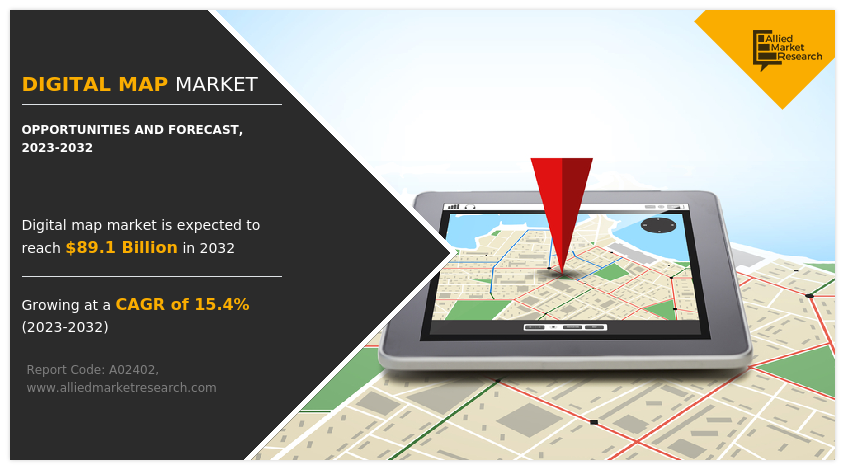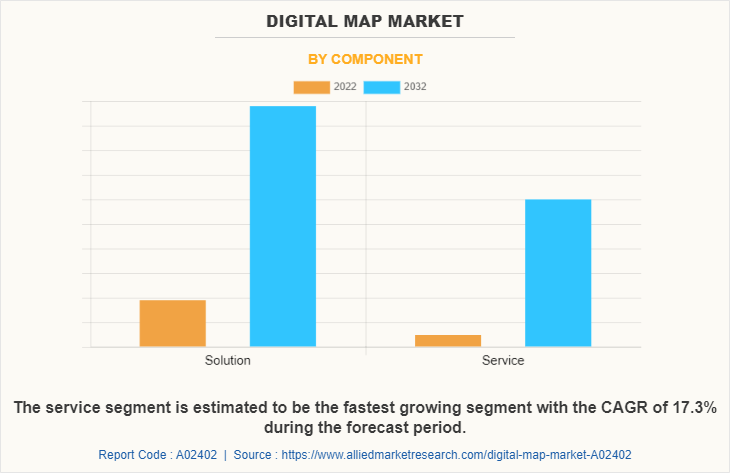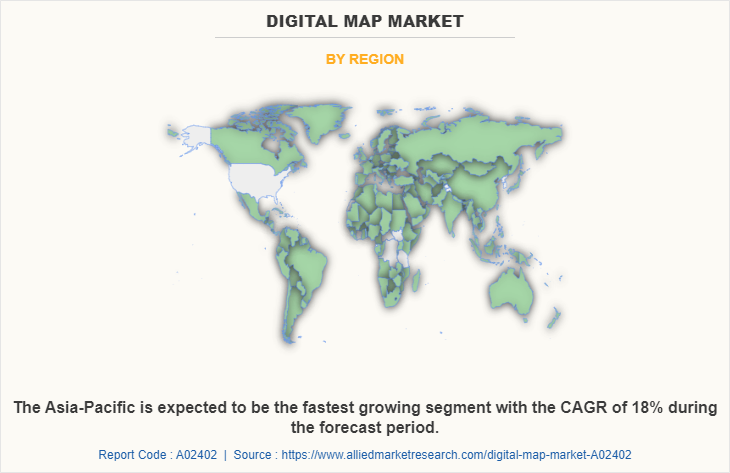Digital Map Market Size & Share:
The global digital map market was valued at USD 21.8 billion in 2022 and is projected to reach USD 89.1 billion by 2032, growing at a CAGR of 15.4% from 2023 to 2032.
Factors such as growth in adoption of mobile computing devices for navigation, wide adoption of 3D platforms, and advanced technologies for surveying and digital map-making are expected to propel the growth of the digital map market forecast. In addition, increasing demand for location-based services across various sectors such as transportation, logistics, and retail are utilizing digital maps to enhance their operations, improve customer experiences, and optimize resource allocation. This digital map market trends is driven by the growing prevalence of smartphones, GPS-enabled devices, and the need for real-time navigation and geospatial data. However, availability of free crowdsourcing digital maps and legal challenges restrict the growth.

Furthermore, the surge in adoption of real-time digital maps offers a strong opportunity for the digital map industry. In addition, integration of advanced technologies into digital mapping, such as artificial intelligence (AI) and machine learning (ML) are also expected to provide lucrative opportunities for digital map market growth during the forecast period. Moreover, the rise of Internet of Things (IoT) devices and sensors is generating vast amounts of location-based data, further fueling the demand for advanced mapping technologies.
Digital map refers to the process of creating and displaying geographic information in a digital format. It involves the use of computer technology to collect, store, manipulate, analyze, and present spatial data. Digital maps can represent various features and phenomena such as terrain, roads, buildings, rivers, boundaries, and points of interest. These maps are typically created using Geographic Information Systems (GIS) software, which allows for the integration and analysis of multiple layers of spatial data.
One of the most significant benefits of digital mapping is its ability to provide accurate and up-to-date information about a particular location. Digital maps can be continuously updated with new data, allowing users to see changes in real-time. This makes digital mapping particularly useful in emergency situations, where timely and accurate information can be critical for response and recovery efforts. Furthermore, digital mapping can also help improve planning and decision-making in a variety of industries.
For instance, in urban planning, digital maps can be used to identify areas of high population density or traffic congestion, helping city officials to better plan transportation routes and public services. In agriculture, digital maps can be used to analyze soil types and nutrient levels, helping farmers to optimize crop yields and reduce waste. In addition, digital mapping can also aid in environmental conservation efforts. By mapping sensitive ecosystems and habitats, researchers and conservationists can identify areas that need protection and develop strategies to minimize human impact.
The digital map market is segmented into component, application, and region. By component, it is divided into solution and services. Based on application, this study includes indoor and outdoor applications. Region wise, the market is analyzed across North America, Europe, Asia-Pacific, and LAMEA.

By component, the solution segment dominated the digital map market size in 2022 and is expected to continue this trend during the forecast period. The increase in need to address connectivity and data integration issues enforce various operators to adopt digital mapping solutions. However, the service segment is expected to exhibit the highest growth during the forecast period. The adoption of digital mapping services enhances software implementation, maximizes the value of existing installation by optimizing it, and minimizes the deployment cost & risks, and others, which is expected to provide lucrative opportunities for the market growth during the forecast period.

By region, North America dominated the digital map market share in 2022 for the market. This is due to an increase in investment in location-based technology and a rise in digital initiative by government or public agencies in this region. This is anticipated to propel the growth of the market. However, Asia-Pacific is expected to exhibit the highest growth during the forecast period. This is attributed to the increase in penetration of digitalization and higher adoption of advanced technologies such as artificial intelligence (AI), machine learning (ML)) and others are expected to provide lucrative growth opportunities for the digital map market in this region.
Top Impacting Factors:
Increase in use of geospatial information
Geospatial information has witnessed a boom in recent years as it is used in a wide range of applications, covering various sectors and businesses such as risk and emergency management, infrastructure management, marketing, urban planning, resource management (oil, gas, mining, and others), business planning, logistics, and others. Geo-information is also a foundation of future applications as it makes it possible to establish location, which is one of the key dimensions of context.
For instance, Atos SE uses geographic information system (GIS) platforms with location-based services (LBS) to offer services to businesses involved in supply chain management, data centers, infrastructure development, urban planning, risk and emergency management, navigation, and healthcare. In addition, technologies based on augmented reality utilize GIS information and 3D platforms to provide virtual information about users and their surroundings. This information helps enterprises understand the needs of users and send targeted advertisements to them.
Rise of Internet of Things (IoT) devices and sensors generating location-based data
The rise of Internet of Things (IoT) devices and sensors generating location-based data is significantly impacting the digital map industry by providing a wealth of real-time and dynamic information. IoT devices, such as connected vehicles, smartphones, wearable devices, and environmental sensors, generate vast amounts of location-based data that can be utilized to create more detailed and comprehensive digital maps.
These IoT devices and sensors capture various types of data, including traffic patterns, air quality measurements, pedestrian movement, and infrastructure conditions. This data can be integrated with digital maps, allowing for real-time monitoring and analysis of different geographical factors. For instance, traffic congestion can be accurately assessed by aggregating data from multiple IoT devices, enabling better traffic management and route optimization.
By leveraging IoT-generated data, digital map providers can offer more precise and timely information to users. This can include real-time traffic updates, predictive maintenance notifications, or personalized recommendations on the basis of user preferences and contextual data. Enriched digital maps enhance navigation experiences, support informed decision-making, and enable more efficient resource allocation.
Moreover, the integration of IoT-generated location-based data into digital maps opens opportunities for innovative applications across various industries. For instance, in urban planning, IoT data can be utilized to identify areas of high energy consumption or detect patterns in waste management. This can help sustainable urban development strategies and optimize resource allocation. Such factors are anticipated to fuel the growth of the digital map market.
Regional Insights:
The global digital map market is expanding rapidly, driven by increasing demand for real-time location data, advancements in geospatial technology, and widespread adoption of smartphones and connected devices. Various regions are seeing growth based on local factors such as urbanization, government initiatives, and the rise of industries like transportation, logistics, and smart city infrastructure.
North America
North America leads the digital map market due to the presence of major technology companies like Google, Apple, and Mapbox, which offer advanced mapping solutions. The region has seen strong demand for digital maps in industries such as transportation, logistics, and autonomous vehicles. For instance, Google Maps remains a dominant player, continuously adding new features, such as real-time traffic updates and indoor mapping. The adoption of digital maps is also increasing due to smart city initiatives. For example, New York and Los Angeles have invested heavily in smart city technologies, including digital maps for urban planning and management.
Europe
Europe is another key market for digital maps, driven by the region's focus on technological advancements and its strong automotive industry. Countries like Germany, the UK, and France are leading the development of autonomous vehicles, heavily reliant on high-precision digital maps for navigation and safety. In addition, European governments are investing in digital mapping solutions for infrastructure management. For example, the EU-funded Galileo satellite system enhances the accuracy of location-based services across Europe, further driving the adoption of digital maps for transportation, public safety, and environmental monitoring.
Asia-Pacific
Asia-Pacific is one of the fastest-growing markets for digital maps, with countries like China, India, Japan, and South Korea seeing increasing adoption across various sectors. In China, Baidu Maps and Alibaba’s Amap dominate the market, with integration into ride-hailing services, food delivery, and logistics. India's government-backed "Bhuvan" project and private initiatives like MapMyIndia are driving the digital map market with a focus on smart cities and infrastructure. The rapid expansion of the e-commerce and delivery industries in the region, particularly during the pandemic, has further boosted demand for real-time digital mapping solutions.
Latin America and MEA
Latin America and the Middle East & Africa (MEA) are emerging markets for digital maps, primarily driven by the increasing use of smartphones and internet access. In Brazil, digital maps are being used extensively for logistics and e-commerce, while in the UAE, mapping technologies are key to smart city initiatives such as Dubai’s integrated smart transportation system.
Key Benefits for Stakeholders:
- The study provides an in-depth digital map market analysis along with the current trends and future estimations to elucidate the imminent investment pockets.
- Information about key drivers, restraints, and opportunities and their impact analysis on the digital map market size is provided in the report.
- The Porter’s five forces analysis illustrates the potency of buyers and suppliers operating in the digital map industry.
- The quantitative analysis of the global digital map market for the period 2022–2032 is provided to determine the digital map market potential.
Digital Map Market Report Highlights
| Aspects | Details |
| Market Size By 2032 | USD 89.1 billion |
| Growth Rate | CAGR of 15.4% |
| Forecast period | 2022 - 2032 |
| Report Pages | 315 |
| By Component |
|
| By Application |
|
| By Region |
|
| Key Market Players | Alibaba Group Holding Limited, TomTom International BV, Nearmap Ltd., ESRI, MapQuest, ARC Aerial Imaging Limited, MiTAC Holdings Corp., Apple Inc., HERE Technologies, Google LLC |
Analyst Review
According to the CXOs of leading companies, the digital map market provides lucrative opportunities to the key players. Increase in scope of applications of advanced mapping solution & services, such as geospatial mapping, disaster mapping, urban planning, and energy management, have contributed toward the digital mapping market growth. Prominent players in the market have developed and launched new technologies, such as Beacons, E-GPS, and A-GPS to cater to a wide customer base globally. For instance, July 2022, BAE Systems launched advanced M-Code GPS receivers for ground-based missions to Germany through the Foreign Military Sales (FMS) process. Under a contract with the U.S. Space Systems Command, BAE Systems will deliver its Miniature Precision Lightweight GPS Receiver Engine “M-Code (MPE-M)”, providing precise geolocation and positioning capabilities in complex and contested operational environments for ground-based soldiers and vehicles and other space-constrained applications.
Furthermore, the increasing investment in transportation & logistics, healthcare, and other sectors in the Asia-Pacific region for digital mapping is expected to provide lucrative opportunities for market growth during the forecast period. For instance, in June 2019, IndoorAtlas and Siam Commercial Bank (SCB) partnered with Faculty of Medicine Siriraj Hospital to launch new digital healthcare services in Siriraj Hospital in Thailand. Siriraj hospital premises have around 10,000 daily users and the new services have been designed to improve patient and staff experiences. Such an enhancement will provide lucrative opportunities for market growth during the forecast period. However, the demand for advanced mapping technology is expected to significantly increase across sectors such as transportation, agriculture, government & public agency, and healthcare, among others.
Moreover, the expansion of e-commerce and the need for efficient last-mile delivery solutions provide avenues for digital mapping to optimize logistics and enhance supply chain management. Furthermore, key market players have adopted product launch, acquisition, and partnership strategies to improve their product portfolio and expand their business outreach. These factors are expected to provide lucrative growth opportunities for market players in the near future.
Furthermore, the digital map industry is experiencing trends driven by the demand for location-based services and advancements in technologies such as AI and IoT. While privacy concerns and regulatory challenges exist, there are substantial opportunities for companies to provide innovative mapping solutions, especially in the fields of autonomous vehicles, smart cities, and e-commerce. By addressing the restraints and leveraging these opportunities, the digital map industry can continue to evolve and shape understanding and interaction with the world.
Global Digital Map Market is Expected to Reach $89,078.56 Million by 2032.
The North America is the largest market for the Digital Map.
Factors such as growth in adoption of mobile computing devices for navigation, wide adoption of 3D platforms, and advanced technologies for surveying and digital map-making are expected to propel the growth of the market during the forecast period.
The key growth strategies for Digital Map include product portfolio expansion, acquisition, partnership, merger, collaboration and others
Apple Inc., Google LLC, HERE, Alibaba Group Holding Limited, TomTom International BV, MiTAC International Corporation and ARC Aerial Imaging Limited, Esri, Nearmap Ltd., and MAPQUEST are some of the top companies
Loading Table Of Content...
Loading Research Methodology...



